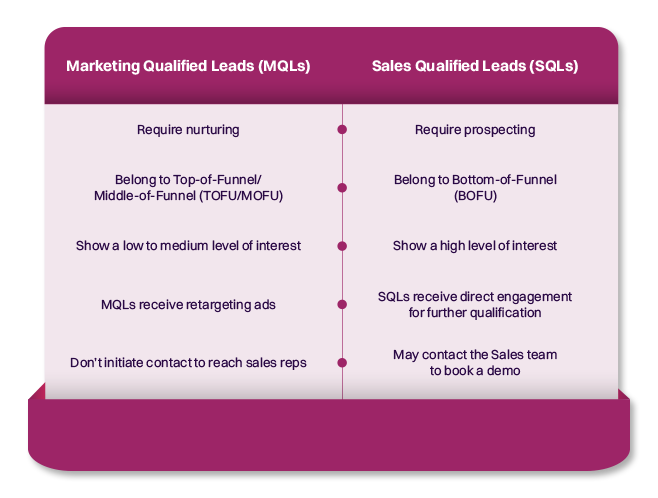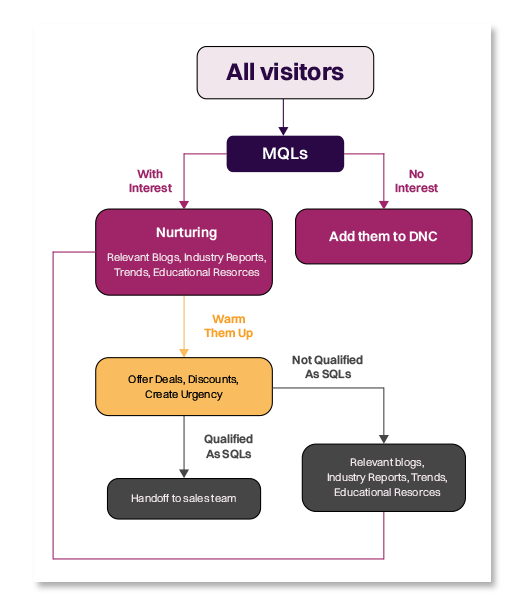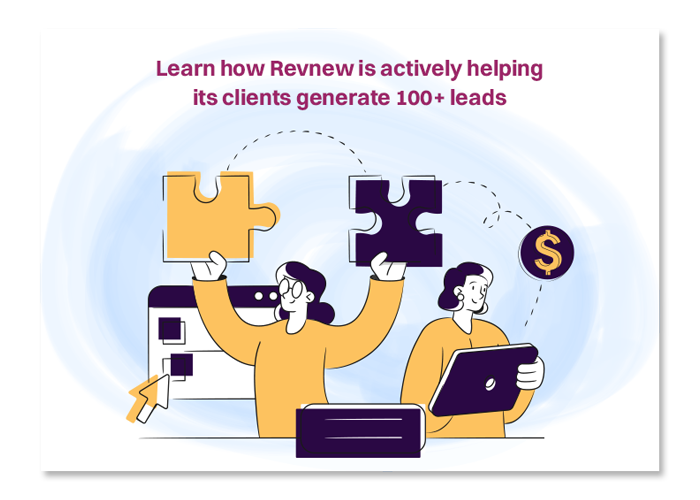
MQLs Vs. SQLs: A Easy Guide On Marketing And Sales Leads
You must nurture each of your leads based on their unique pain points, concerns, and expectations. When you group your leads depending on these factors, you get to separate your marketing-qualified leads (MQLs) from sales-qualified leads (SQLs). Knowing the difference between MQLs and SQLs' needs and nurturing them based on the information helps you get an effective marketing outcome.
So, here we present a detailed MQLs Vs. SQLs comparison for you to get a clear idea of their differences. Next, we’ll learn best practices for MQL to SQL conversion.
Take a quick look at the basic differences between MQLs and SQLs:

Detailed Overview Of MQLs vs. SQLs
MQLs Vs. SQLs differences revolve around certain leads’ traits and their roles in the sales process.
Let's start with understanding MQLs.
1. Marketing Qualified Lead

A. Definition
A Marketing Qualified Lead, or MQL, is a promising lead for the sales team to follow up with. The term "Marketing" reflects lead generation through marketing efforts, such as email campaigns, social media advertising, or content marketing.
The term "Qualified" reflects that the lead meets certain criteria. To qualify a lead, your marketing team evaluates factors like engagement level, product suitability, etc.
Of course, not all MQLs will turn into paying customers. But they are an important part of the sales funnel as they provide valuable insights into your marketing campaigns' performance.
B. Characteristics
- Engagement With Marketing Materials
It reflects a lead’s interactions with your marketing content. But, before considering a lead as your MQL, you must measure their engagement levels. Let's understand it with an example:
Imagine a scenario where a sales development representative (SDR) receives a potential customer's contact information. Upon investigating, the sales rep finds out that the customer has shown interest in multiple marketing materials provided by the company. To assess the level of interest displayed by the potential customer, the SDR takes into account various actions taken by the customer. For instance, the customer may have:
- Read the company's email
- Clicked through to the landing page
- Watched the video demo
- Attended Webinar
- Downloaded the company's content
With this information, the SDRs determine whether the lead meets the criteria to become a Marketing Qualified Lead.
- Fit Within The Target Groups
An MQL aligns with the company's target audience and buyer personas. They match the criteria for the ideal customer, for instance, in terms of demographic factors, including age, gender, industry, etc. - Have A History Of Interaction With The Company
The MQL interacts with the company's marketing team in some way. They must show a willingness to learn more. It may include subscribing to a newsletter or participating in a survey. - Appropriate Position In The Customer Journey
The MQL may not yet be ready to purchase, but they actively consider their options. They may research different product options, compare prices, or evaluate your offerings with the competition.
C. Role in the Sales Funnel
74% of companies not hitting revenue goals didn't know their marketing qualified leads. MQLs' role in the sales funnel is to tell which prospects to focus on. Once you know them, you can continue to engage and nurture the relationship. These leads are more likely to move forward in the sales funnel.
The sales team can serve MQLs in the following manner:
- Provide more detailed product/service information.
- Answer any questions the lead may have.
- Address the lead's concerns or objections.
2. Sales Qualified Lead (SQL)
A. Definition
A Sales Qualified Lead (SQL) is a potential customer who has passed the MQL qualification and is likely to make a purchase. An SQL goes beyond just showing interest and engaging with your company. Their actions indicate they are ready for a sales conversation.
It can include actions like contact us form filling, demo requests, or initiating a live chat. Identifying and nurturing SQLs is an integral part of the sales process. It helps to focus efforts on those who are most likely to convert into paying customers.
B. Characteristics
- They Have The Needed Budget:
An SQL has a budget sufficient to purchase your product/service. Plus, they have the financial means to invest in the offered solution. - Authority To Make The Purchase Decision:
SQL has the authority to make the purchasing decision on behalf of their organization. Thus, they often serve as a decision-maker or an influencer with the power to approve the purchase. - Need Of Your Product/service:
The SQL has a specific need for your service or a pain point your product/service can solve. They clearly understand how the product/service can benefit their organization. - Have A Set Purchase Timeline:
The SQL has a timeline in mind for making the purchase. Typically, they have a planned timeframe for making the purchase. It could be by the following month or quarter.
C. Role In The Sales Funnel
SQLs indicate which target prospects are ready to become customers.
High-performing sales development representatives (SDRs) can effectively differentiate between sales leads and opportunities.
Because they can convert these SQLs into meaningful sales pipelines. In B2B industries, 59% is considered a good SQL-to-opportunity conversion rate.
Moreover, they signal your sales team to apply various sales techniques, including personalized communication, targeted offers, and persuasive messaging.
SQLs enable sales teams to leverage upselling and cross-selling opportunities. Further, the conversion rate of SQLs to paying customers reflects the sales reps’ performance and effectiveness of sales strategies.
Best Practices To Convert MQLs To SQLs
Typically, 13% is an ideal benchmark for the average B2B MQL to SQL conversion rate. However, it varies across different lead source channels. Among these channels, websites show a standard conversion rate of 31%, while referrals show a 24% conversion rate.
However, you can boost your MQL to SQL conversion rate by implementing these best practices:
1. Focus On Converting The Most Promising MQLs First
Start with defining what a promising MQL looks like.
First, work with your sales and marketing teams to establish promising MQL criteria.
Next, assign a score to each MQL based on your established criteria. Then, shortlist the most promising leads from the MQLs list and start nurturing them.
Use personalized messaging to nurture leads. Keep your brand top of mind and continue providing value over time.
For example, if you are a Payroll-system provider, an ideal marketing-qualified lead for your product would be businesses struggling with pay management. But, instead of going after all such companies, pick the ones that fit your high-value MQL criteria. They can be businesses actively seeking a payment solution than those not out there.
2. Set Up Sales Alerts
Always stay on top of your sales pipeline with the help of sales alerts. It makes sure you don’t miss any opportunity to connect with a potential customer. Here's what you'll have to take care of:
- Determine what events to trigger alerts. Such as:
- When a new lead joins your CRM.
- When a prospect opens an email.
- When a deal is won or lost etc.
- Choose an alert tool that integrates with your existing CRM and other sales and marketing systems. It must allow you to customize your alerts based on your specific needs.
- Set up alerts to respond quickly to any new opportunities or potential issues. Additionally, set up multiple alerts for different members of your sales team. It'll keep everyone informed, helping them take appropriate action promptly.
3. Put Time Limits On Follow-Ups
Research says around 44% of sales reps are too busy to follow up on leads. Thus, having a well-scheduled timeline to connect with prospects can help streamline the process.
Follow these steps for an effective sales lead follow-up:
Step 1. Start by setting a clear deadline for each follow-up action you take. It could include:- Sending a proposal
- Scheduling a demo
- Making a phone call
Setting a deadline will help you prioritize your tasks. Additionally, it'll ensure that you're making progress promptly.
Step 2. Streamline your follow-up process and save time with automation. Here's what you can do:- Set up email drip campaigns that automatically send a series of follow-up emails
to prospects at regular intervals. - Use a scheduling tool to automate setting up calls and meetings.
Step 3. Use your CRM to track your interactions with prospects and customers. Further, prioritize prospects based on their importance and set follow-up reminders accordingly.
4. Create A Task In The CRM That Allows Sales To Take Action On The MQL
Studies say that CRM software can increase productivity by 34% and sales by 29%. You can use reliable and high-performing CRM tools like HubSpot automation solutions and Salesforce sales and marketing solutions that over 158,000 and 150,000 global businesses trust, respectively. Besides sales & marketing ops, these CRM solutions also optimize revops.
Here's a sample setup of a CRM task that allows the sales team to automate the desired action on the MQL:
Task: Follow up with MQL and qualify them for SQL status.
Description: Contact the MQL identified on (date) and determine if they meet the criteria for SQL status. Qualification criteria include (insert specific criteria such as budget, authority, need, timeline).
If the MQL meets the criteria, update their status to SQL and schedule a sales discovery call. If the MQL does not meet the criteria, move them from sales pipeline to nurturing funnel.
Due Date: Insert the date and time for when the task is due.
Assigned To: Insert the name of the sales team member responsible for completing the task.
Notes: Insert any relevant notes or information about the MQL or the task
5. Define Your Sales Cadence Model
Sales cadence refers to knowing the right time and outreach type for unique prospects.
Depending on your MQL's role within the target organization, you can determine the above two points.
- Engage via phone calls with potential customers
- Connect with follow-up emails
- Share supporting sales/marketing content for further interaction
It will help minimize engagement lapses.
Conclusion
In conclusion, knowing the difference between MQLs Vs. SQLs are crucial.
It helps your business interact with leads in an ideal manner. On the one hand, MQLs show a high level of interest in your company's products/services. On the other hand, SQLs are qualified by the sales team and are ready for direct sales engagement.
You can move them down the sales funnel by tailoring marketing and sales strategies. Hence, you can ultimately convert them into customers.
We suggest you choose Revnew, an expert B2B lead generation agency. We combine AI technologies and human intelligence to create an exclusive marketing strategy for your business.





